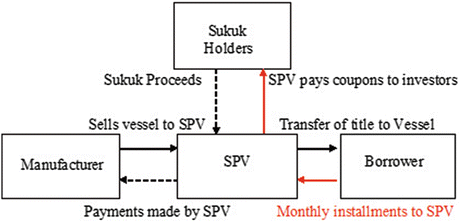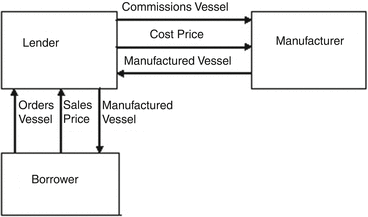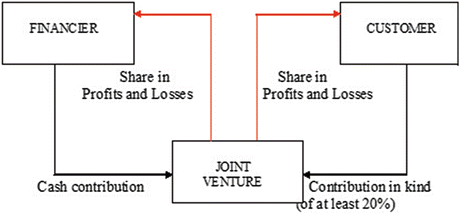Islamic Finance in Shipping: Dawn of a New Reality

Fig. 18.1
Murabaha transaction
18.3.1.1 Example of Murabaha Finance
In July 2011, Saudi Arabia’s National Shipping Company (NSCSA) signed a US$ 219 million Murabaha financing agreement with Saudi British Bank (SABB) and National Commercial Bank (NCB).
Eighty per cent of the funding will be made by SABB along with NCB, which will finance the construction of two general cargo ships, while NSCSA will finance the remaining 20 %.
The deal has a 12-year tenor and will be repaid in equal quarterly instalments with a balloon repayment of approximately 30 % of the contract value at the end of the Murabaha period.5
18.3.1.2 Risk Management Tools in Murabaha
Risk No. 1—Borrower refuses to purchase the asset from the lender
This can be managed to a great extent by utilising a promise to purchase instrument as well as an earnest deposit, to be obtained from the borrower right at the beginning, so that it can cover the lender’s risk in taking the title to the assets under the Murabaha.
Risk No. 2—Overdue and/or late payment(s) by the borrower
As late payment “penalties” to the lender are prohibited in Islamic finance, an undertaking from the borrower is usually obtained that he/she will give a certain amount of money to charity in case of any late payments. Though none of the parties benefits from such charity payouts, the payment is intended to act as a deterrent for breach of the contract.6
Risk No. 3—Default risk
This risk, which accompanies any financial transaction, can be negated to a great extent by the realisation of the securities/collateral taken from the borrower to recover the losses. Takaful (Islamic insurance policy) schemes may be taken up for ownership-related risks in Islamic Murabaha transactions as well.
18.3.2 Istisna’a (Procurement)
An istisna’a financing is a cash sales contract made against the promised future delivery of goods. It is similar in character to a “Murabaha” financing and therefore the risk management tools that is applicable in a Murabaha transaction is equally applicable in an Istisnaa and so the same are not repeated in this section. Istisna’a is used for funding major construction projects. A shipbuilding contract is an ideal agreement that can be financed by means of an Istisna’a as it includes the pre-delivery financing of a ship under construction, but bears all the requirements for a Sharia’a-compliant financing structure.
An Istisna’a transaction (see Fig. 18.2) can be described as follows:
1.
The borrower (i.e. the ship-owner) first negotiates and reaches a final agreement with the chosen shipyard on all the terms and conditions of the shipbuilding contract.
2.
The borrower then requests the lender to finance the construction of the vessel (as contemplated by the shipbuilding contract) by entering into an independent Istisna’a agreement and pays an earnest deposit (arboun), representing the borrower‘s own equity share in the vessel, to the lender.
3.
The Istisna’a agreement will essentially mirror the terms of the pre-agreed shipbuilding contract and will also contain the provisions and conditions of the credit relationship between the lender and the borrower as well.
4.
The lender will then execute and enter into the pre-agreed shipbuilding contract with the shipyard on behalf of the borrower and will pay the arboun as the first instalment to the shipbuilder.
5.
Thereafter, the instalment payments—as agreed in the shipbuilding contract and subject to the qualifications thereof—will be made by the lender to the shipyard.
6.
Upon the delivery of the completed vessel under the shipbuilding contract to the lender, the vessel is immediately sold to the borrower for a pre-agreed price (which includes the cost price plus the lender’s margin on the same) under the Istisna’a agreement.
7.
The lender may alternatively also agree to refinance the borrower by taking delivery of the vessel under its own name or its SPC and then leasing the vessel to the borrower under an Ijara wa iqtina’a (lease with an option to purchase) structure.

Fig. 18.2
Istisna’a transaction
18.3.2.1 Example of Istisna’a Transaction
The financing of Brunei Gas Carriers (BGC) through a syndicated Islamic ship financing transaction in July 2008 is a classic example of an Istisna’a operation in practice. The joint primary underwriter and book runner, facility agent and Islamic finance coordinator was Saadiq (Standard Chartered’s Islamic finance department). Under an Istisna’a/Ijara structure (pre-delivery construction facility and forward lease), a best-in-its-class Sharia’a-compliant financial solution for US$505 million was made available to BGC to fund the construction and procurement of its liquefied natural gas (LNG) vessels.7
18.3.3 Musharaka (Partnership Financing or Profit and Loss Sharing)
Though the Musharaka has not been widely used in ship finance, it is a useful and flexible structure that can be adapted for assets, such as finance for sea-going vessels, as well as for assets that are of a certain type or age for which other forms of finance would be expensive and/or complex. In a Musharaka transaction, all parties have a share in the capital and according to this capital ratio, the profits as well as losses (if any) of the transaction/venture/project are divided between the parties. Each partner is considered an agent of the other. However, the management of the entire project may be conducted by just one party, as may be agreed in the Musharaka agreement. The Musharaka is increasingly gaining popularity as a method for financing purchases of second-hand vessels.
A Musharaka transaction (see Fig. 18.3) may be described as follows (Muhammad 2009):
1.
The borrower and the lender first enter into a Musharaka or partnership agreement, wherein they agree to contribute certain predetermined amounts respectively toward the construction or the purchase and delivery of a vessel.
2.
The Musharaka agreement prescribes that once the vessel has been delivered, it will be legally owned under the name of the borrower. This is, more importantly, for the benefit of the partnership (i.e. the Musharaka).
3.
The Musharaka agreement will set out the respective profit and loss rates for the partners and these will correspond to their equity contributions to the Musharaka.
4.
The borrower, as it would be most knowledgeable about the subject matter of the Musharaka, is also appointed the technical partner and acts as the trustee of the partners in the Musharaka.
5.
Significantly, the Musharaka agreement will, in most cases, also reference a bareboat charter agreement between the borrower and a third party charterer or other similar agreement of employing the asset/vessel, which is the subject matter of the Musharaka.
6.
In accordance with a pre-agreed schedule of payments as per the construction or purchase agreement of the vessel, both the lender and the borrower make payments to the seller/manufacturer of the vessel in accordance with their pre-determined ratios.
7.
Upon delivery, the vessel is then engaged into the bareboat charter with the third party charterer as referenced in the Musharaka agreement. The charter payments received by the borrower from the charterer are applied (whether partially or fully) to purchase an increasingly greater share in the Musharaka in favour of the borrower until the lenders portion of the equity is eventually bought out by the borrower.

Fig. 18.3
Musharaka transaction
18.3.3.1 Example of Musharaka Finance
The Al Islami Shipping Fund of the Dubai Islamic Bank (DIB) (managed by Tufton Oceanic) is utilised by the Oceanic Shipping Company Limited (which is also 100 % owned by DIB) to invest the same in selected shipping assets through Musharaka joint ventures with investors. The underlying investments are intended to be ocean-going vessels on bareboat charters to major shipping groups with “end-of-term” purchase obligations included in the Musharaka. The minimum investment amount was US$25,000, with total investment units worth US$32 million available. The tenor of the funds is 4 years and the same is extendable up to a maximum of two more years. The fund is targeting an estimated profit rate of 8.5 % per annum with a quarterly distribution of profits. The first deal under the fund was the purchase of a very large crude carrier (VLCC) from Saudi Pac Star, which was then leased back.8
18.3.3.2 Risk Management Tools in Musharaka Finance
Risk No. 1—Misconduct, breach of contract, negligence by a partner in taking care of the Musharaka assets, and so on.
To counter such risks, adequate security or guarantees from the partners have to be obtained by the lender(s) at the time of entering into the Musharaka agreement itself. Clauses may be inserted into the Musharaka agreement, wherein a partner in default of his/her minimum care obligations is required to pay certain fixed amounts for charitable purposes. This can act as a deterrent as well (Lewis and Algaoud 2001).
Risk No. 2—Loss of capital or assets, etc.
Adequate Takaful or insurance coverage for all ownership-related risks must be taken and there must be active participation either by the lender(s) themselves or by competent managers or experts in the management of the Musharaka business. Alternatively, a third party (e.g. the parent entity) guarantee for capital loss, subject to Sharia’a conditions and qualifications, could also be extremely useful.
18.3.4 Ijara (Lease)
Another popular method of Islamic finance is the Ijara (lease) transaction, wherein the usufruct of an asset (e.g. a vessel) is passed to the other party (the lessee) against a periodic rent payment, with an option to buy the asset at the end of the lease period. The Ijara transaction is preferred by investors opting for longer term, higher yielding investments (Muhammad 2009). The fundamental conditions for a valid Ijara transaction are that the asset must have a corpus (body) and should be in existence at time of the lease. The asset in question must also not be consumable in nature (i.e. the nature of the asset is such that it should not vanish if utilised as, for example, money, food, etc.).
An important factor to bear in mind is that in an Ijara, all ownership rights and responsibilities incidental to ownership of the asset will remain with the lessor (i.e. lender) and he/she will bear all the risks related to ownership till the asset/vessel is transferred to the ownership of the borrower. Advantages under the Ijara transaction include flexibility in payment terms and other provisions for transferability as well as the possibility of a hire purchase structure. Ijara is very useful in buying second-hand vessels or for refinancing vessels already owned.